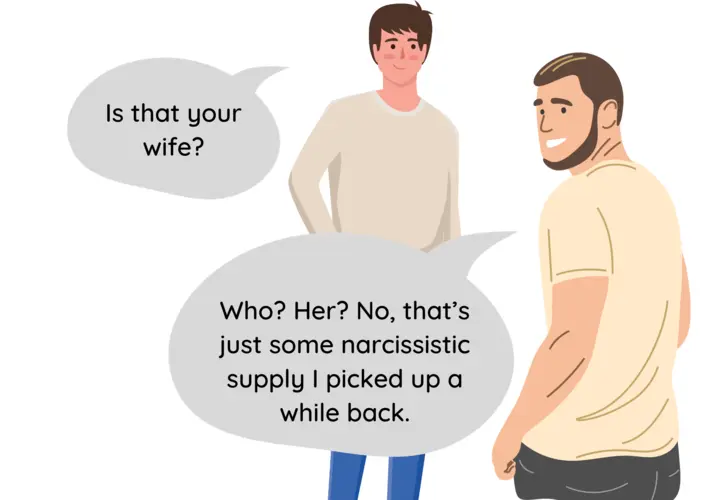If you’re trying to protect yourself from narcissistic abuse, one of the most important things you must learn about is the narcissistic abuse cycle.
The narcissistic abuse cycle refers to an abusive pattern of behavior that characterizes the relationships of people with narcissistic traits. The first phase is idealization, the second is devaluation, the third is discarding, and the fourth is hoovering. This cycle keeps the person being abused trapped in the relationship.
In this article, I am going to guide you through each phase of the narcissistic abuse cycle.
1.) Idealization (Love-Bombing)
The first phase of the narcissistic abuse cycle is idealization.
The term “idealization” refers to the action of regarding or representing something as perfect or better than in reality.
During this initial phase, narcissists commonly use a combination of mirroring and love bombing to present themselves as the perfect partner.
Love bombing manifests in the form of them showering the person they are abusing with a false sense of love, compliments, gifts, and promises of a perfect future.
Suggested Reading: What Do Narcissists Do During the Love Bombing Phase?
Mirroring manifests as copying the desires and interests of the person they abuse to pretend they share the same values, dreams, and passions.
As a result, the person being abused ends up feeling understood, valued, and supported on a profound level.

This manipulative strategy is designed to make the abused person dependent on the narcissist’s affection and approval.
2.) Devaluation
The second phase of the narcissistic abuse cycle is devaluation.
The term “devaluation” refers to the reduction or underestimation of the worth or importance of something.
This phase typically begins once the person the narcissist is abusing becomes emotionally invested in the relationship.
What this looks like is instead of being “loving” and “attentive,” the narcissist becomes critical, dismissive, emotionally distant, and abusive.
The narcissist will begin to degrade the person they are abusing through various manipulation tactics such as gaslighting, baiting, and projection.
Suggested Reading: 8 Ways That Narcissists Make You Feel Crazy
Because of this, the abused person becomes confused and tries to reconcile the “loving” and “attentive” person they fell for with the increasingly cruel and indifferent person they’re now dealing with.
A common question people have after learning about this phase is, “Why didn’t the person being abused just leave?”

The answer is intermittent reinforcement.
This term means the delivery of a reward at irregular intervals.
For example, the narcissist will be abusive for weeks and then occasionally drops “rewards” in the form of “compliments” or displays “affection.”
This tactic keeps the person being abused hooked in the relationship and hoping for a return of the person who they fell for during the idealization phase.
Suggested Reading: Why Do Trauma Bonds Feel Like an Addiction?
3.) Discarding
The third phase of the narcissistic abuse cycle is discarding.
Discarding means to get rid of (someone/something) as no longer useful or desirable.
This phase happens because narcissists typically don’t view the people they abuse as individuals with thoughts, feelings, and emotions of their own.
They view them as sources of validation, admiration, reassurance, power, and control, also known as narcissistic supply.

This can be hard to hear, but narcissists typically don’t care about the well-being of the person they are abusing.
Because of this, it is common for the narcissist to abruptly end the relationship or become so emotionally abusive or distant that the relationship is virtually over.
Suggested Reading: Why Do Narcissists Discard So Easily?
This is discarding.
Experiencing this after the highs of the idealization phase and the lows of the devaluation phase often leaves those being abused devastated and full of self-doubt.
It is common for them to begin to blame themselves for the narcissist’s change in behavior and go to great lengths to win back their approval.
4.) Hoovering
The fourth phase of the narcissistic abuse cycle is hoovering.
The term “hoovering” refers to a tactic that occurs when a narcissist says and/or does exactly what you need to hear and/or see to give them another chance.
Here are some common phrases a narcissist might use during this phase:
- Promises of Change: “I’ve realized my mistakes, and I’ve changed.” “I’m seeing a therapist now.” “I promise I will never hurt you again.”
- Playing the Victim: “I can’t live without you.” “I’m lost without you.” “My life is falling apart, and I need you.”
- Minimizing Past Behavior: “You’re overreacting. It wasn’t that bad.” “I never did that.” (This is also known as gaslighting.)
- Guilt-Tripping: “After everything I’ve done for you, this is how you treat me?” “I thought you were different, but you’re just like everyone else.”
- Love-Bombing: “You’re the love of my life.” “We’re meant to be together.” “No one else understands me like you do.”
- Flattery and Gifts: “I saw this and thought of you.” “Remember the good times we had when…”
- Threats and Manipulation: “If you leave me, I’ll hurt myself.” “You’ll never find someone who loves you as much as I do.”
- Feigning Helplessness: “I can’t handle this on my own. I need your help.”
As you can see from those phrases, during the hoovering phase, it is common for narcissists to use various tactics like pretending to have changed, making grandiose promises, playing the victim, guilt-tripping, or even threats and manipulation.
If the person being abused falls for these tactics, the cycle of abuse starts all over again with a return to the love-bombing phase, which is also commonly referred to as the honeymoon phase in this context.
The honeymoon phase is a period that occurs right after an instance of physical, sexual, or emotional abuse.
During this time, the abuser will typically “apologize” for their behavior while showing sorrow and promising that the abuse will never happen again.
What Should You Take Away from This Article?
There are four phases in the narcissistic abuse cycle. The first is idealization, the second is devaluation, the third is discarding, and the fourth is hoovering.
This abusive pattern of behavior keeps those experiencing narcissistic abuse trapped in the relationship, which is why being aware of it is so important.
Thank you so much for reading this article. I hope you found it helpful!
About the Author

Hey, I’m Elijah.
I experienced narcissistic abuse for three years.
I create these articles to help you understand and validate your experiences.
Thank you for reading, and remember, healing is possible even when it feels impossible.
